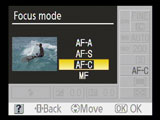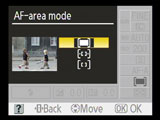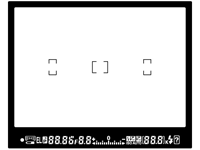Nikon D40 with AF-S Nikkor 18-55mm 1:3.5-5.6 G II ED
-
-
Written by Gordon Laing
Nikon D40 lenses
Lenses and viewfinder / Screen and menus / Sensor and processing
Lenses and viewfinder / Screen and menus / Sensor and processing
The Nikon D40 has an F-mount which can accommodate most Nikkor lenses, although the latest models are required to support all the exposure, metering and flash features. Incompatibilities with older accessories is understandable, but the D40 takes a further step away from ‘legacy’ kit by being the first Nikon DSLR not to feature the built-in motor required to auto-focus older lenses. These lenses will still work on the D40, but you’ll need to manually focus them. The D40 will only auto-focus with AF-S or AF-I compatible lenses.
Nikon omitted the motor to keep the D40’s size and weight down, and has understandably come under some criticism for doing so. To be fair, the D40’s target audience are most likely to use modern AF-S compatible lenses, although sadly some popular third party options won’t autofocus – for example Sigma’s non-HSM models, such as the 18-200mm, can only be manually focused on the D40. Ultimately if you own, or are thinking of picking up any non AF-S compatible lenses and want auto-focus capabilities then buy yourself a D80, or even a second hand D50 instead.
Like all Nikon DSLRs so far, the D40’s DX format sensor results in the field of view of all lenses being reduced by 1.5 times, so the DX 18-55mm II kit lens delivers an effective focal range of 27-83mm. The range of bundled 18-55mm kit lens is shown below. While the 18-55mm is the most common kit lens, alternatives may include the Nikkor 18-135mm. A great second lens to complement the standard 18-55mm though is the new Nikkor 55-200mm VR, one of the most affordable lenses with optical stabilisation.
Nikon D40 with DX 18-55mm II coverage | ||
 |  | |
| 18-55mm at 18mm, f8 (27mm equivalent) | 18-55mm at 55mm, f8 (83mm equivalent) | |

|
Nikon D40 focusing
 |
 |
The Nikon D40 employs a new Multi-CAM530 focusing module with three focusing points. This makes it considerably less sophisticated than the nine-point AF systems of rivals like the Canon EOS 400D / XTi or the 11-point system of its bigger brother the D80. That said the D40’s three point system is fine for general use and we rarely experienced a time when it didn’t snap onto the desired subject. If you’re into tracking subjects which regularly move around the frame though, the 400D / XTi or D80 could be a better bet.
The D40 has four focusing modes: AF-S for single subjects, AF-C for moving subjects, AF-A which automatically selects between AF-S and AF-C, and finally, Manual focusing. You can also adjust the AF area mode to prioritise on subjects closest to the camera, subjects in a dynamic area or those fixed by a manually-selected focus point.
Viewfinder
 |
The Nikon D40 employs a penta-mirror type optical viewfinder which delivers 95% coverage and 0.8x magnification. In practice it doesn’t appear as big or bright as the D80’s excellent penta-prism viewfinder, although it looks roughly equivalent to that of the Canon EOS 400D / XTi. To our eyes, the D40’s viewfinder appeared fractionally brighter than the 400D / XTi when fitted with their respective kit lenses (same apertures) presumably due to differences in their actual focusing screens.
The D40’s viewfinder is dominated by the three focus point indicators with outlines which illuminate when active; this looks a little classier than the dots which illuminate on the EOS 400D / XTi’s focus points, although as mentioned above, the latter does at least feature a considerably more sophisticated nine-point AF system. Sadly the on-demand viewfinder LCD grid lines of the D80 aren’t present here, and there’s also no depth-of-field preview.
In addition to the usual exposure details and compensation scale, the D40’s viewfinder can also display a flashing question mark as a warning when it believes the picture may be spoilt by a technical aspect; pressing the question mark button on the back of the camera then presents some helpful advice, such as ‘Lighting is poor, flash recommended’.





